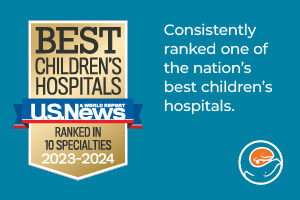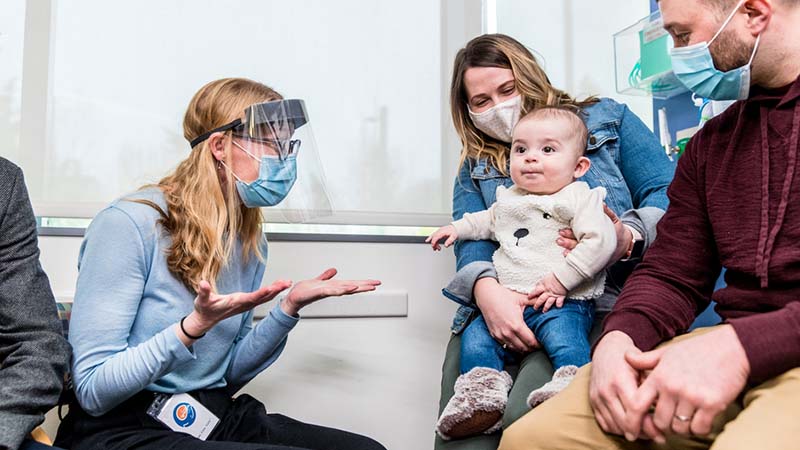Congenital Diaphragmatic Hernia
Contact the Fetal Care and Treatment Center
What is a congenital diaphragmatic hernia?
A congenital diaphragmatic hernia (CDH) happens if the diaphragm does not form completely before birth. This leaves a hole between your baby’s belly (abdomen) and chest. Organs that should be in the belly go through the hole up into the chest, crowding the lungs. The condition is pronounced kun-JEN-ih-tul dy-uh-fruh-MA-tik HER-nee-uh.
A CDH can be life-threatening. Babies with a CDH have small lungs and the lung tissue is different. This causes breathing problems and high blood pressure in their lungs (pulmonary hypertension). Some children with a CDH have other health problems, too.
-
What causes congenital diaphragmatic hernia?
A CDH is present at birth (congenital). The problem happens early in pregnancy while the diaphragm is forming. Researchers are looking at possible causes, such as certain chemicals, nutrients or changes in genes. A CDH is not caused by something the parent did or did not do while they were pregnant.
Why choose Seattle Children’s for congenital diaphragmatic hernia?
Our Congenital Diaphragmatic Hernia Program offers more specialized care than any other children’s hospital in our region (Washington, Alaska, Montana and Idaho). Our multidisciplinary team has cared for hundreds of children with a CDH, from prenatal diagnosis through early adulthood. We provide evidence-based care with excellent survival outcomes, even for the sickest babies.

During pregnancy, the CDH team at our Fetal Care and Treatment Center will check your baby’s health to prepare for their birth and care. We work closely with your birth hospital and are national leaders in safely moving fragile newborns. We were the first children's hospital on the West Coast to offer mobile extracorporeal membrane oxygenation (ECMO). Seattle Children’s has the largest Extracorporeal Life Support Program for babies, children and teens in the Northwest. Our Level IV Neonatal Intensive Care Unit (NICU) is skilled and equipped to care for the sickest newborns. Your child will receive care from Seattle Children’s pediatric experts in surgery, hearts and lungs.
You are a key part of your child’s care team. We fully support your family so you can bond with your newborn and take part in their care. As your child grows, our CDH Program gives your family a single place to get check-ups, follow-up treatment and advice from a team of experts.
 “There is so much patience and grace at Seattle Children’s. Not only did my family start inside those walls, I also learned how to be a mom with the help of nurses, doctors and countless medical staff. I will forever be thankful.”
“There is so much patience and grace at Seattle Children’s. Not only did my family start inside those walls, I also learned how to be a mom with the help of nurses, doctors and countless medical staff. I will forever be thankful.”
– Cassie Fannin, who first came to Seattle Children’s when she was pregnant with Summer.
See: After Life-Saving Surgery, Summer Overcomes the Odds
What are the symptoms of congenital diaphragmatic hernia?
Babies with a congenital diaphragmatic hernia (CDH) may have:
- Serious breathing problems, starting soon after they are born
- Increased work of breathing, for example, using belly muscles to breathe in
- Rapid breathing
- Fast heart rate
Breathing problems happen because:
- Their lungs are smaller than normal.
- Their hearts cannot pump blood easily to the lungs because the walls of the blood vessels are too thick.
- The organs that slip through the hole between the belly and chest are pushing on their lungs.
How is congenital diaphragmatic hernia diagnosed?
In most cases, doctors diagnose a CDH from an ultrasound during pregnancy. Most often, this happens between 20 and 24 weeks of pregnancy. A dedicated CDH team in our Fetal Care and Treatment Center will help you prepare.
We do imaging studies such as MRI (magnetic resonance imaging) and ultrasound to help us predict how sick your baby will be at the time of birth. This helps us plan for your baby’s delivery and counsel you on what to expect.
-
After birth
Sometimes, a CDH is not diagnosed until after a baby is born. A doctor or nurse who checks your baby after birth may find:
- Irregular chest movements with breathing trouble
- No breathing noises on the side that is affected
- The belly feels less full and looks flatter than normal
Your baby may have these tests to find the cause of any breathing trouble:
- Checking oxygen levels across the skin (pulse oximetry) and with blood tests
- X-ray to see if organs are in the chest instead of the belly
- An ultrasound image of your baby’s heart (echocardiography)
-
In older babies and children
Sometimes, providers find a CDH in an older baby or a child who has had many colds or other illnesses that affect their breathing. This is less common. It requires surgery to close the hole in the diaphragm, but is much less serious than a CDH in a newborn.
Prenatal Care for Congenital Diaphragmatic Hernia
Our CDH prenatal team includes specialists in maternal-fetal medicine, surgery, neonatology, cardiology and genetics. During pregnancy, you can get to know members of the team who will be caring for your child after birth. At a visit to our hospital, you can see where we will care for your baby and learn about the resources we have for families.
A dedicated CDH team in our Fetal Care and Treatment Center will:
- Monitor your baby’s health during pregnancy
- Do tests to determine the severity of your baby’s CDH
- Help you prepare for what lies ahead
- Work with your birth hospital to plan for a safe delivery and the special care your baby will need at birth
- Arrange your baby’s safe transfer to Seattle Children’s
We do these tests soon after your baby is diagnosed and sometimes later in pregnancy:
- Fetal MRI
- Fetal echocardiogram: A cardiologist who specializes in fetal care and CDH will check the fetal echocardiogram. You will be able to meet with our cardiology team and discuss these results.
Treating Congenital Diaphragmatic Hernia
At Seattle Children’s CDH Program, a coordinated team of surgeons, neonatologists, cardiologists, pulmonologists, pediatric intensivists and nutritionists will treat your child. The same team of pediatric surgeons and neonatologists will be involved in your baby’s care before their birth and throughout their hospital stay. This allows us to get to know your baby very well and give them the very best care.
Bonding with your baby is vital to their well-being. As soon as it is medically safe, you can touch, talk to and hold your baby. When your baby is stable, we welcome you to take part in their care (even change diapers). You will learn and practice all your baby’s care before going home.
 “We felt really loved and cared for — they explained everything so well and prepared us for what was to come. He is thriving today, thanks to the incredible care we received at Seattle Children’s over the last nine years.”
“We felt really loved and cared for — they explained everything so well and prepared us for what was to come. He is thriving today, thanks to the incredible care we received at Seattle Children’s over the last nine years.”
– Laurina Barker, mom of Matthew, born with a CDH
See: Boy Born With Severe Birth Defect Rises Up For a Brighter Future
-
Breathing support
- We will monitor your baby closely — especially their heart and lungs — and adjust their treatment as needed.
- Starting soon after birth, babies with a CDH need to be on a machine (ventilator) to help them breathe. We give your baby sedation to help them feel relaxed. They might be slightly drowsy or sleepy.
- We use gentle ventilation strategies to support your baby’s breathing and prevent damage to their lungs.
- Breathing support is needed because their lungs are small and they have high blood pressure in their lungs. Your child may need to be on the ventilator for days or for weeks. It depends on when their lungs are ready to take over.
- Once they are off the ventilator, most babies with CDH need oxygen through a tube into their nose. Some babies will still need a small amount of oxygen when they go home.
- Babies with severe problems may need to be on a machine that does the work of their heart and lungs. This is called ECMO or extracorporeal life support (ECLS). “Extracorporeal” means outside the body. Prenatal imaging helps us predict whether your baby will be among the small number of newborns who need ECMO. Only about 15% of babies we treat need ECMO, compared to the national average of 30%.
- Your baby’s lungs will have more space after a surgeon fixes their diaphragm and moves other organs back into their belly. This allows lung size and blood pressure in the lungs to improve over time.
-
Nutrition and feeding
- During the time from birth until surgery recovery, most babies with a CDH get all their nutrition through an intravenous (IV) line.
- As they recover from surgery, your baby will be fed using a tube that passes through their nose into their stomach (nasogastric tube or NG tube). Many babies need an NG tube for at least part of their nutrition, even when they are ready to leave the hospital.
- If you are planning to breastfeed your baby, our nurses and lactation specialists will do all that they can to keep your milk flowing and to build a milk supply for your baby.
- Some babies have problems with milk or formula flowing backwards from their stomach into their esophagus. This is called gastroesophageal reflux (GER) and could affect their lungs. If this happens, we make a small opening through the wall of your baby’s belly and place a tube into their stomach. This lets us safely feed your baby until they can eat by mouth. Reflux symptoms in most babies with CDH get much better over time.
- When your baby is ready, our nurses and feeding therapists help with the transition to feeding by bottle or breast.
- If it is not safe to feed your baby by mouth yet, we will teach you and your family how to care for a feeding tube at home. Almost all babies can feed by mouth within a couple of months after going home.
-
CDH surgery options
- All babies with a CDH need surgery to gently move their abdominal organs down from their chest. The surgeon closes the hole in the diaphragm with stitches or a patch of synthetic material.
- Your baby may have the surgery a few days after birth or weeks later. The timing depends on what is safest for your baby.
- There are different ways to do the surgery. Your baby’s surgeon will talk with you about the options. We will recommend the best treatment for your child.
- Our dedicated team of anesthesiologists specialize in caring for babies with CDH. We use gentle ventilation that allows for a smooth transition between the NICU and operating room.
-
Hospital care after CDH surgery
After surgery, your child will continue to receive the highest level of care in our Level IV NICU. When your baby no longer needs a ventilator and is stable, they will move out of the NICU to a regular hospital room. There we will work on feeding skills, weight gain and helping them breathe without extra oxygen. When it is safe, we help to transition from tube feeding to feeding by mouth.
Each child’s recovery is different. Most babies stay 8 to 10 weeks. But a hospital stay may last a few weeks or many months. Your baby will be ready to go home once they:
- Breathe on their own or with a tube in their nose for a small amount of extra oxygen
- Can gain weight without IV nutrition
-
Going home
We will help you connect with a primary care provider before your baby leaves the hospital. This helps ensure your baby gets the close follow-up they will need once they go home.
Our nurses will help set up the supplies and equipment you need. This may include oxygen, medicine or tube feeding. You will have lots of time to practice all your baby’s care before going home.
Follow-up care as your child grows
A few weeks after your baby goes home from the hospital, we will see them in our CDH follow-up clinic at Seattle Children’s hospital campus. Most babies are seen a lot at first and less often over time. How often depends on how much feeding and breathing support they have when they first go home. We offer telehealth visits to families across our region (Washington, Alaska, Montana and Idaho).
We provide as much support as you need so you do not feel overwhelmed at home. If your baby leaves the hospital on a tube feeding and oxygen support, we help safely wean them off when they are ready.
Some children will have no long-term problems. But many children born with a CDH need care until their teen years or longer. Our CDH Program team has the specialists your child may need to manage and prevent all the known complications related to CDH. Our team includes a surgeon, pulmonologist, nutritionist and cardiologist.
To provide complete care for your child and family, we create a follow-up plan and a schedule that is right for your child. Some children may come only for a yearly check-up. Others may come more often.
Our team:
- Provides the ongoing treatment your child needs
- Refers you to the experts for a range of issues, such as occupational therapy, nutrition and neurodevelopmental support
- Is a resource for your child's pediatrician
We focus on helping you know what to expect, such as:
- How your child's condition and surgery may affect their growth and development
- How often your child should visit for an exam
- What tests they may need
- Which treatments or services may help with your child's current health concerns
- What to watch for so any new problems can be found and treated early
Ongoing health issues for some children include:
- High blood pressure in their lungs: If your baby continues to have this problem (pulmonary hypertension) when they are ready to go home from the hospital, they may need oxygen and medicines for a while. Our heart and lung specialists will make sure your child gets the care they need.
- Gastroesophageal reflux (GER): The backward flow of stomach contents into the esophagus is common in children born with a CDH. This can be uncomfortable and make feeding harder. Reflux can also worsen some breathing symptoms. Your child may need medicine or, rarely, surgery to manage reflux.
- Feeding problems: Our occupational therapists help babies develop feeding skills. Some babies have problems related to reflux. Many need a nose-to-stomach tube (NG tube) for at least part of their nutrition. This provides gentle, safe feedings until a child grows out of GER and learns to eat safely.
- Heart defects, such as being born with a hole in their heart: Your child will get care from experts in our top-ranked Heart Center.
- Frequent, serious colds: Children born with a CDH have lungs that are smaller and stiffer than normal during the first few years of life. They may be much more likely to get colds and take longer to recover than other children. We recommend special vaccines to prevent the most serious infections.
- Asthma: Your child has a greater chance of having asthma than kids who do not have a CDH. To help prevent symptoms, avoid common irritants like smoke, dust and some animals. Our team watches for early signs of asthma to be sure it is treated correctly.
- Curved spine (scoliosis).
- Problems with how the chest wall forms (pectus carinatum or pectus excavatum).
Overall outcomes for babies born with a CDH are excellent. Most children who receive follow-up CDH care at Seattle Children’s meet expected milestones for growth and development by the time they start school. We look forward to supporting your family from the prenatal period through young adulthood. When the time comes, we help transition your child to a provider who cares for adults.
Contact Us
Prenatal care
- If you are pregnant and would like an appointment, call 206-987-5629 or email the CDH Program. See our location and contact information.
- You can also ask your healthcare provider to refer you to our Fetal Care and Treatment Center.
- If you are a provider, see our referral guidelines for more information.
Request a second opinion
- We offer virtual second opinion consultations. Call 206-987-5629 or email the CDH Program. A member of our team will contact you within 2 business days to begin coordinating your consultation.
Follow-up care during childhood
- If your child needs follow-up care, contact our CDH Program at 206-987-0780. You do not need a doctor’s referral.
- The CDH follow-up care clinic is located at Seattle Children’s main campus.
Telemedicine at Seattle Children's
We offer telehealth visits to families across our region (Washington, Alaska, Montana and Idaho). Learn more about phone and video appointments.
Related Links
Paying for Care
Learn about paying for care at Seattle Children’s, including insurance coverage, billing and financial assistance.
For Healthcare Professionals
-
Schedule an appointment
- Talk with your pregnancy care provider for a referral.
- If you have a referral, call Fetal Care and Treatment Center at 206-987-5629 to schedule an appointment.
- If your child needs follow-up care for CDH, contact our CDH Program at 206-987-0780.
- How to schedule.
If this is a medical emergency, call 911.
-
Find a doctor
- Meet the Congenital Diaphragmatic Hernia team.
-
Locations
- Fetal Care and Treatment Center at Springbrook Professional Center: 206-987-5629
- Congenital Diaphragmatic Hernia Program at hospital campus: 206-987-0780
-
Refer a patient
- For a second opinion, call 206-987-5629 or email the CDH Program.
- Consultations (providers only): Call 206-987-5629.
- If you are a provider, fax a Prenatal Appointment Request Form (PDF) (DOC) to 206-985-3407.
- View our complete information on referring patients to the Fetal Care and Treatment Center.
